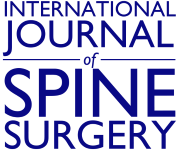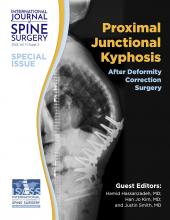Abstract
Adult spinal deformity (ASD) is a complex pathology associated with spinal malalignment in the coronal, sagittal, and axial planes. Proximal junction kyphosis (PJK) is a complication of ASD surgery, affecting 10%–48% of patients, and can result in pain and neurological deficit. It is defined radiographically as a greater than 10° Cobb angle between the upper instrumented vertebrae and the 2 vertebrae proximal to the superior endplate. Risk factors are classified according to the patient, surgery, and overall alignment, but it is important to consider the interplay between various factors. This article reviews the risk factors of PJK and considers alignment-focused prevention strategies.
Footnotes
Funding The authors received no financial support for the research, authorship, and/or publication of this article.
Declaration of Conflicting Interests Bassel G. Diebo discloses the following: consulting fees from SpineVision. Alan H. Daniels discloses the following: consulting fees from Stryker, Orthofix, Spineart, and EOS; research support from Southern Spine; fellowship support from Orthofix. Frank Schwab discloses the following: consulting fees from Mainstay Medical, Medtronic, Zimmer; IP royalties from K2M, Medtronic Sofamor Danek; research support from DePuy, Nuvasive, and Stryker; board member for International Spine Study Group. Virgine Lafage discloses the following: consulting fees from Alphatec Spine, Globus Medical; IP royalties from Nuvasive; board member for International Spine Study Group, Scoliosis Research Society. The remaining authors have nothing to report.
- This manuscript is generously published free of charge by ISASS, the International Society for the Advancement of Spine Surgery. Copyright © 2023 ISASS. To see more or order reprints or permissions, see http://ijssurgery.com.







